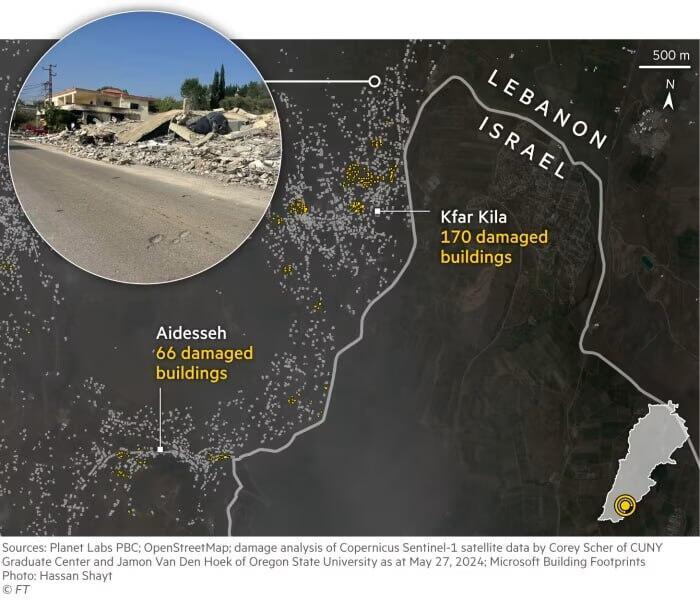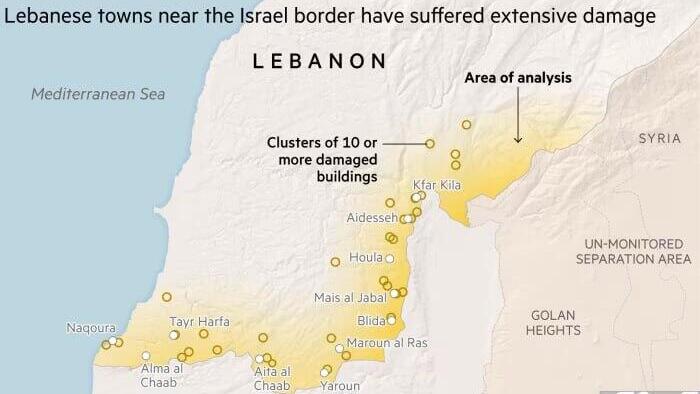Getting your Trinity Audio player ready...
Recent Israeli airstrikes have effectively created a "dead zone" extending just over 3 miles into Lebanese territory, the London-based Financial Times reported on Thursday. This development could be seen as an effort to establish a de facto security buffer zone in the region. The report, based on satellite imagery and expert analysis, highlights that the IDF has been targeting buildings and infrastructure primarily within this 3-mile stretch along the Israeli border – an area that is now largely abandoned. The aim, it seems, is to push Hezbollah operatives away from the Israeli border.
Villages in southern Lebanon
An IDF official clarified to the newspaper that "this is not a buffer zone. We only want to push Hezbollah back. We have no issue with UNIFIL or with Lebanese civilians residing there. But we must clear the area of Hezbollah’s presence, since their operatives pose a direct threat to Israeli homes through sniper fire, anti-tank missiles, border infiltrations and other means. It's a tactical necessity to ensure the security of Israeli residents."
However, the report notes that these strikes have rendered the area "uninhabitable," effectively transforming it into a de facto buffer zone – an area that serves as a strategic target for Israel in Lebanon. This buffer zone constitutes one-sixth of southern Lebanon, which, according to UN Resolution 1701, should be entirely Hezbollah-free. The resolution clearly stipulates Hezbollah should remain "north of the Litani River," and that southern Lebanon should be free of any armed forces other than UNIFIL and the Lebanese Army.
Claims of an actual "security zone" in southern Lebanon come amid frustration and anger from residents of northern Israel, who perceive a similar creation of a "security zone" in parts of the Galilee that have been evacuated. According to the current report in the Financial Times, while approximately 60,000 residents were evacuated from northern Israel, UN data indicates that about 95,000 residents have been evacuated from southern Lebanon. The report claims that over 90 civilians have been killed in IDF strikes in the area, alongside about 300 Hezbollah terrorists.
Authorities in southern Lebanon assert that more than 3,000 buildings have been completely destroyed by IDF strikes since Hezbollah began attacking Israel in "solidarity" with the Palestinians in Gaza on October 8. However, satellite data analysis published by the Financial Times suggests a lower number –reporting that only about 1,500 buildings have been severely damaged, including many homes. The report emphasizes that this is a relatively conservative estimate.
Sources and residents who spoke to the British newspaper claimed that, earlier this year, IDF strikes began to approach urban centers in southern Lebanon. Although Lebanon accuses Israel of targeting civilian sites, the IDF stresses that the strikes are aimed solely at terrorist targets. "Every third house in southern Lebanon is used by Hezbollah for storing weapons, training, firing positions, and meeting points for possible attacks across the border," a senior Israeli military official told the Financial Times.
Lebanese officials claim that this is not the case, and eight sources and local residents told the British paper that when Lebanese civilians exploited short breaks in the fighting to return to their homes and collect belongings, those homes were attacked within hours. Residents see these as warning strikes from the IDF, interpreting them as threats against their return.
Hassan Shait, the mayor of the town of Qafr Kila, which has been attacked frequently by Israel, claims this happened to his sister. According to him, after several weeks of being away, she returned to her home last April during the Eid al-Fitr holiday to collect her belongings. Shait claimed that the house was attacked two hours after she left. "The Israelis didn’t like it, so the house was hit and completely destroyed," he said.
According to the report, in some villages near the Israeli border, entire neighborhoods have been destroyed. Shait claims there are neighborhoods that "look like Gaza" and "every day, the destruction just keeps increasing." In the coastal town of Naqoura, the destruction is also extensive – a resident there told the Financial Times: "Our beloved village looks like a ghost town."
The newspaper noted that reporters spoke with this resident during a funeral held in Naqoura for two Hezbollah terrorists. The residents reportedly believe that Israel will not attack during funerals and take advantage of them to briefly return to their homes and assess the damage. The interviewed resident cried when he saw his children's toys among the ruins of his destroyed home: "It’s the same in every village within a 10 km radius from here," he claimed.
The report on the extent of the destruction in southern Lebanon comes amid great fear worldwide of a full-scale war between Israel and Hezbollah, and increasing warnings from countries for their citizens to leave Lebanon. Israel has been signaling for a long time that patience with the continuous attacks on northern settlements is wearing thin, but Hezbollah Secretary-General Hassan Nasrallah refuses a political settlement with Israel as long as the war in Gaza continues. During his meetings in the U.S., Defense Minister Yoav Gallant hinted that the expected transition soon to Phase G in the fighting in Gaza – meaning the end of the intensive operation in Rafah – will have implications for the northern front.
Amid calls from politicians in Israel to conquer territory in southern Lebanon and create a real security buffer zone, like the one Israel withdrew from in 2000, a senior Lebanese official expressed hope to the Financial Times that diplomatic efforts – as well as the "buffer zone" created in southern Lebanon – "will be sufficient to prevent a broader war." However, the same Lebanese official warned that the war would escalate if Israel tried to execute what he called its "stupid plan," which he claimed aims to completely eliminate Hezbollah. Israel, however, has never declared such an objective.






